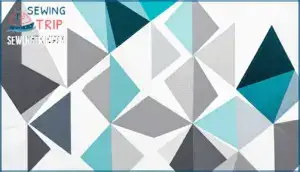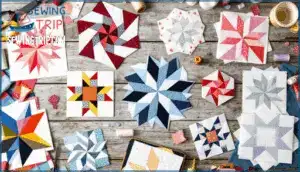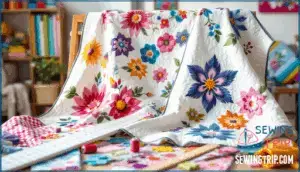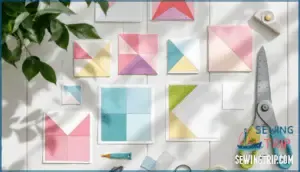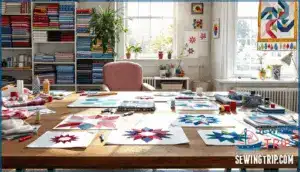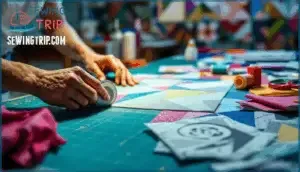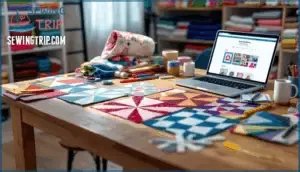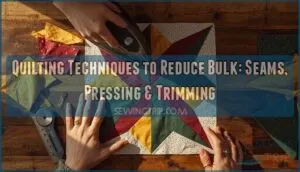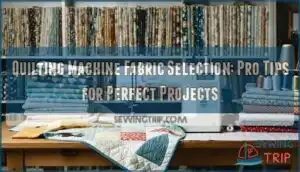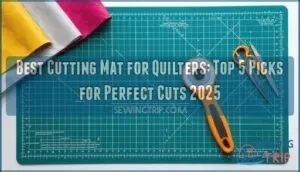This site is supported by our readers. We may earn a commission, at no cost to you, if you purchase through links.
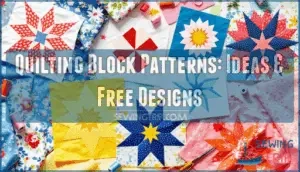 You’ve probably got a stack of fabric scraps gathering dust, or maybe you’re staring at a blank design wondering where to start. The truth is, quilting block patterns are where the magic happens—they’re the foundation that transforms random pieces of fabric into something people want to wrap themselves in.
You’ve probably got a stack of fabric scraps gathering dust, or maybe you’re staring at a blank design wondering where to start. The truth is, quilting block patterns are where the magic happens—they’re the foundation that transforms random pieces of fabric into something people want to wrap themselves in.
Whether you’re drawn to the timeless elegance of a Nine-Patch from the 1800s or the bold geometry of modern designs gaining traction with over half of today’s new quilters, there’s a pattern waiting for your style.
From classic star blocks to trendy appliqué designs, you’ve got endless ways to build your skills and create quilts that feel entirely yours. Let’s walk through the patterns, techniques, and strategies that’ll help you stitch something truly special.
Table Of Contents
Key Takeaways
- Modern geometric quilt blocks are surpassing classic patterns among new quilters, with over half now preferring bold geometry and online interest jumping 38% recently.
- Accuracy in cutting, pressing, and seam allowances (1/4 inch standard) is the foundation that separates amateur blocks from professional-looking results—small precision wins prevent major headaches later.
- Multiple piecing techniques exist for different skill levels: traditional piecing for reliability, foundation paper piecing for intricate geometric designs, English paper piecing for portable hand-stitching, and appliqué for fast-track embellishment.
- Free quilt block patterns are abundant online (260+ available), organized by difficulty level and theme, making it easy to find patterns that match your skill level without spending money.
Popular Free Quilt Block Patterns
Whether you’re just starting out or looking to expand your pattern collection, there are tons of free quilt block designs that work for every skill level. From the classic simplicity of nine-patch blocks to bold modern geometry, you’ve got options that’ll inspire your next project.
Let’s explore some popular patterns that quilters keep coming back to.
Classic Nine-Patch Blocks
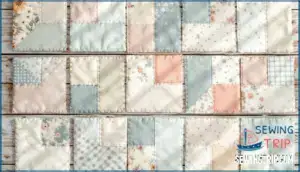
The Nine-Patch block is one of quilting’s oldest block patterns, dating back to the early 1800s. This timeless design features nine equal squares arranged in a 3×3 grid, making it perfect for beginners. You’ll find Nine-Patch blocks in Smithsonian collections from 1825–1850, showing how settlers used this patchwork block pattern to teach children and reuse fabric scraps efficiently.
Modern quilters still love it for sampler projects and eco-conscious upcycling. Its simple structure lets you create endless design variations while mastering technical assembly basics. Many quilters appreciate the simplicity and appeal of this classic design.
Modern Geometric Designs
If Nine-Patch blocks feel too traditional, modern geometric designs offer something fresher. These clean-lined patterns use triangles, hexagons, and chevrons to create bold, minimalist quilts that still honor quilting heritage.
Over half of new quilters now prefer geometric blocks over classic motifs, and online interest in these patterns jumped 38% recently. You’ll find asymmetrical layouts and negative space designs gaining ground too. Quilters often find that precision and symmetry are key elements in these designs.
Whether you’re drawn to Amish-inspired symmetry or abstract geometry, digital design tools make creating your own geometric patterns easier than ever. The modern quilt movement proves quilting keeps evolving while staying rooted.
Star Quilt Block Patterns
Star patterns have deep roots in American quilting history. The Lone Star emerged around 1845 in Texas, while Plains tribes adopted the Morning Star design for ceremonial occasions—each point symbolizing honor and hope.
Today, you’ll find core designs like the Ohio Star and Lemoyne Star alongside modern adaptations using digital templates and foundation paper piecing.
Whether you’re drawn to traditional eight-point radial symmetry or contemporary minimalist layouts, star blocks offer endless creative possibilities while honoring quilting’s rich heritage.
Appliqué Quilt Block Ideas
While star blocks celebrate tradition, appliqué designs let you paint with fabric. These blocks—featuring flowers, animals, and seasonal motifs—are having a major moment. Floral patterns top the trend list, but modern geometric appliqué and Halloween themes are gaining ground fast.
You’ve got options: fusible web for speed, needle-turn for precision, or a hybrid approach. With over 500 patterns available online and downloads up 31% this year, you’ll find historical blocks like the Dresden Plate alongside contemporary creations.
The beauty? Appliqué works for beginners and experts alike.
Beginner-Friendly Quilt Block Ideas
Starting with beginner-friendly blocks is your best move—they’re simple enough to build confidence without requiring specialty tools or complicated techniques.
Each block you’re about to see uses common piecing methods and basic shapes, so you can focus on getting comfortable with your machine and developing solid seam skills.
Let’s walk through some classics that have helped countless quilters get their start.
Pinwheel Blocks
If you want a quilt block that looks like it’s spinning, pinwheel blocks are your answer. These classic patchwork blocks use four half-square triangles (HSTs) arranged in a four-patch layout, making them perfect for beginners.
Dating back to early 1800s frontier quilts, pinwheel patterns symbolized windmills—and today they’re featured in modern projects across quilting communities.
You can customize with two-color simplicity or multi-color variations for movement. Common sizes are 6½", 8", and 10" finished blocks. Their adaptability makes them ideal for quilt-alongs, mystery samplers, and scrap fabric projects.
Shoo Fly Blocks
If the Pinwheel feels like a windmill, think of Shoo Fly blocks as the folk art classic that’s been teaching quilters for generations. This traditional nine-patch uses five solid squares and four half-square triangles in a 3×3 grid. Dating to the 1850s, Shoo Fly blocks remain perfect for beginners mastering straight seams and simple shapes.
A standard 14-inch block needs one fat quarter each of print and background fabric. You’ll find countless free quilt block patterns online—their symmetry and limited piece count mean fewer mistakes and faster skill-building for beginner projects.
Hourglass Blocks
If you’ve mastered the Shoo Fly’s straight seams, Hourglass blocks are your next natural step—they’re deceptively simple yet visually striking. These quarter-square triangle blocks form an X-shaped center that draws the eye, making them perfect for beginners building confidence.
Originally designed in the 1800s, hourglasses remain popular today for their clean geometry and adaptability. The "4-at-a-time" technique boosts productivity by 75%, while smart fabric choices between light and dark values create impressive depth.
Try mixing scraps to reduce waste by up to 30%—this approach teaches you color balance while making your stash work harder.
Maple Leaf Patterns
Here’s the thing—if you want a quilt block that teaches you precision without overwhelming your brain, Maple Leaf patterns are your ideal choice. First documented around 1910, this nine-patch design combines four half-square triangles, four squares, and one stem block into a classic leaf shape that screams autumn.
- Pattern history runs deep: Canadian quilters embraced the Maple Leaf block as cultural symbolism, making it perfect for seasonal projects or heritage pieces.
- Design variations adapt easily: Sizes range from 6 to 18 inches, so you can start small and scale up as your skills grow.
- Modern adaptations thrive online: Join quilt-alongs with hashtags like #MapleLeafQAL to connect with other quilters creating the same blocks.
- Quilting tutorials abound: Digital platforms offer free cutting charts and PDFs, plus step-by-step guidance for mastering those half-square triangles.
Use batiks or contrast-rich cottons to make your leaf pop. The repetitive nine-patch format builds muscle memory for accurate seaming—exactly what you need before tackling trickier blocks.
Techniques for Creating Quilt Blocks
Different techniques let you build quilt blocks in different ways, and each one has its own strengths. Whether you prefer traditional methods or want to try something newer, there’s a technique that fits your style and skill level.
Let’s explore the main approaches quilters use to bring their blocks to life.
Traditional Piecing Methods
Traditional piecing is the backbone of quilting—joining fabric pieces with precise ¼-inch seam allowances to build repeatable blocks. Over 70% of quilters use this technique because it’s reliable and flexible.
You’ll need quality cotton fabric, sharp tools like rotary cutters and patchwork rulers, and consistent pressing between seams to keep blocks square.
The real magic? Chain piecing multiple pairs sequentially saves time while maintaining even tension. Master your seam allowances and fabric selection, and you’ll build accurate blocks every time.
Foundation Paper Piecing
Want to create intricate stars and geometric designs without wrestling with hundreds of tiny pieces? Foundation paper piecing (FPP) is your answer. This technique—with roots stretching back to 15th-century Italy—lets you sew fabric directly onto numbered paper templates, achieving geometric precision that traditional methods can’t match.
You’ll use shorter stitch lengths (around 12 stitches per inch) and follow a simple trim-sew-press sequence. Modern digital templates and sustainable practices make FPP perfect for beginners seeking consistent results with scrap fabrics.
Over 10,000 online tutorials now guide quilters through this foundation paper piecing approach, proving algorithmic design meets accessible quilting.
English Paper Piecing
English Paper Piecing (EPP) offers a refreshingly different path if you’re craving portability and hand-stitched charm. Unlike foundation paper piecing, EPP involves basting fabric around precisely cut paper templates, then joining pieces using whipstitching—a technique that’s been refined since 18th-century England.
You’ll work with hexagons, diamonds, or triangles, cutting fabric with a 3/8-inch seam allowance and folding it neatly around your template. Modern quilters often swap traditional paper for reusable acrylic templates and glue-based basting, making the process faster and more eco-friendly.
EPP shines for travel projects and mindful stitching circles, especially among quilters aged 25–44 who value the flexibility to work anywhere. Whether you’re drawn to classic "Grandmother’s Flower Garden" patterns or contemporary geometric designs, English Paper Piecing patterns remain a beloved gateway into slower, more intentional quilting.
Appliqué Techniques
If English Paper Piecing feels too slow, appliqué techniques offer a faster way to add stunning details to your blocks. This method applies fabric shapes directly to a background, creating bold designs without all the tiny seams.
You’ve got options: Raw Edge appliqué uses visible stitching for a modern look, while Turned Edge hides raw edges for heirloom-quality finishes. Fused Appliqué uses webbing to stick shapes down first, Reverse Appliqué cuts away layers to reveal contrasting colors underneath, and Broderie Perse lets you cut motifs from printed fabric and stitch them on top.
Start with flower applique patterns or simple geometric shapes—they’re forgiving and look wonderful.
Tips for Accurate and Creative Quilt Blocks
Getting your blocks to look sharp and polished takes more than just following the pattern—it’s about mastering the little details that add up to big results.
The good news is that you don’t need fancy tools or complicated tricks to make it happen.
Let’s walk through the key strategies that’ll help you cut accurately, press like a pro, and make creative choices that take your blocks from good to great.
Cutting and Piecing Instructions
Getting the foundation right makes all the difference. Start with properly starched fabric—it reduces stretch along bias edges and cuts down distortion by over 10%. Here’s your cutting and piecing roadmap:
- Align fabric’s folded edge to a 90° mat gridline for perpendicular cuts that keep blocks square
- Apply firm, even pressure across your ruler to stay within ±0.5 mm tolerance and catch dull blade errors early
- Maintain consistent 1/4 inch seam allowances (or scant 1/4 inch) using a quarter-inch presser foot for 25% better uniformity
Chain-piecing keeps seams tight across multiple blocks. Measure units before and after assembly to catch shrinkage that could throw off your final size. Small accuracy wins now prevent headaches later.
Pressing for Flatter Blocks
You’ve nailed the cutting and piecing—now pressing separates amateur blocks from professional-looking ones. Here’s the reality: pressing (up-and-down motion) beats ironing (sliding) by a mile. Ironing stretches seams by up to 5%, while proper pressing reduces seam misalignment by 20–25%.
Use a dry iron at 180–200°C with steady pressure for 4–6 seconds per seam. Let blocks cool under a clapper for 30–60 seconds to lock everything in place. Pre-starch your fabric, nest seams to cut bulk by 35%, and you’ll get blocks flat enough for smooth quilting.
| Pressing Tool | Key Benefit | Impact |
|---|---|---|
| Tailor’s Clapper | Rapid heat absorption | Reduces puffiness 25–30% |
| Wool Pressing Mat | Heat moisture balance | 15% faster cooling |
| High-Heat Dry Iron | Seam stability | 40% improvement vs. steam |
| Pressing Cloth | Protects dark fabrics | Lowers surface temp 20–25°C |
Color Placement Strategies
Think of color placement as the heartbeat of your quilt block design—it’s what makes viewers stop and look.
Here’s what matters:
- Distribute your accent colors across the block rather than clumping them in one spot, which creates better visual balance and flow throughout your design.
- Use a 40-30-30 split: medium tones (40%), light tones (30%), and dark tones (30%) to maintain equilibrium and prevent flat, heavy blocks.
- Place your brightest fabrics strategically as focal points—roughly 20–25% of your design area—to draw the eye and create compelling color harmony.
The real trick? High-value contrast guides movement and emphasizes your pattern geometry, while warm colors advance and cool tones recede. Test your color placement on grayscale first to catch tonal imbalance before you piece a single seam.
Using Scrap Fabrics
Scraps aren’t leftovers—they’re your next quilt’s secret weapon. By organizing remnants into standard sizes (1.5", 2.5", 3.5"), you’ll realize economic benefits: quilters save about 18% per project using scraps.
Foundation paper piecing and improvisational patchwork let you use odd-shaped fabric pieces without waste. Strip-pieced blocks like Jelly Roll Race need scraps as short as 2.5 inches.
This make-do culture reduces landfill textile waste while boosting creative satisfaction. Your free quilt block patterns gain new life when scrap fabric quilting becomes your default approach.
Finding and Downloading Quilt Block Patterns
You’ve got plenty of options for finding quilt block patterns, and the good news is that many of them are free. Whether you’re looking for a specific design or browsing for inspiration, there are libraries and shops that make it easy to get exactly what you need.
Here’s where to start your search.
Alphabetical Pattern Library
Online alphabetical pattern libraries organize hundreds of quilt blocks by name, making it easy to find exactly what you’re looking for. Sites like FreeQuilt.com divide patterns into sections (A–C, D–G, H–M, P–Z), while Scissortail Quilting offers over 200 free downloadable blocks with cutting charts. Jinny Beyer’s famous "Quilter’s Album" catalogs more than 4,000 blocks alphabetically.
Many libraries now include alphabet block sets—like "Best Day Ever"—letting you create all 26 letters for custom projects. Digital accessibility means you can browse, download, and print patterns anytime, making pattern organization and project customization simpler than ever.
Sizing and Cutting Charts
Getting your block size right is everything. A finished 12" block needs different cuts than a 9" block, and your cutting chart is your roadmap. Most patterns assume a 1/4" seam allowance, so an unfinished block is always 1/2" larger than the finished size. That gap matters when you’re calculating fabric width usage and piecing accuracy.
Use these essentials:
- Finished Sizes matter: 6", 9", and 12" blocks work best with standard quilt dimensions and digital design tools like PreQuilt
- Seam Allowance Math: Always add 1/4" to each side of pieces; patterns account for this in cutting instructions
- Fabric Width Usage: Standard quilting cotton runs 42" wide; cutting charts tell you strips to cut "selvedge to selvedge" across the full width
- Cutting Chart Accuracy: Download size-specific charts for your block—they prevent mistakes and save fabric scraps
Online Pattern Shops
Where do most quilters find their patterns today? Seventy percent of online shops offer free patterns alongside paid options, making discovery easier than ever. You’ll find searchable libraries filtered by theme and difficulty, plus video tutorials in half the leading shops.
Social media drives forty percent of traffic to these stores, so peer recommendations matter. Most buyers prefer downloadable PDFs—sixty-three percent, to be exact—making digital pattern access the clear winner.
Revenue models support both designers and shop owners, with experienced pattern creators averaging nearly $24,000 annually.
Frequently Asked Questions (FAQs)
How many free quilt block patterns are there?
You’ve got access to over 260 free quilt block patterns right now, with new designs added regularly. Each pattern includes step-by-step cutting and piecing instructions, plus pressing directions.
Download limitations and copyright restrictions vary by source, so check each site’s terms.
Design complexity ranges from beginner-friendly to skilled, letting you find exactly what matches your skill level.
What are the best quilt block patterns?
The best quilt block patterns depend on your skill level, block size preference, and color schemes. Classic nine-patch and pinwheel blocks suit beginners, while hourglass and maple leaf patterns offer moderate complexity.
Choose based on fabric selection and pattern complexity that match your experience—free quilt block patterns abound online for every preference.
Are there free quilt blocks?
Yes, free quilt blocks exist everywhere. Community sharing sites offer thousands of patterns with different license types—some require designer recognition, while others fall under creative commons.
Pattern availability ranges from simple Nine-Patch designs to complex geometric layouts. Check blogs and quilting communities for downloadable options before purchasing.
When do free quilt blocks start?
Free quilt block patterns are released year-round through designer collaborations, seasonal block availability, and subscription block perks. Pattern release timing varies by source—many quilting blogs drop new designs monthly, while promotional freebies often align with holidays or quilting events.
Check your favorite pattern shops regularly for fresh free quilt blocks.
What is a quilt block?
A quilt block is a self-contained fabric unit made by sewing together squares, rectangles, or triangles in specific patterns. These individual blocks form the foundation of your quilt design.
You’ll sew multiple blocks together to create the quilt top before adding batting and backing fabric.
What can I do with a quilt block pattern?
A paradox: the smallest quilt block becomes your biggest creative playground.
Your blocks transform into individual gifts, charity quilts, and skill-building exercises.
Turn fabric scraps into stunning block-based projects through design innovation. Stack patterns together, mix colors boldly, and watch your quilt block inspiration grow into complete quilting projects and ideas that reflect who you’re.
How do I calculate the number of blocks needed for my quilt size?
Here’s the straightforward math: multiply your desired quilt length by width, then divide by your block’s finished size squared. Most quilters use cheat sheets to skip the calculation.
Account for borders, sashing, and roughly 10% fabric waste in your quilting math for accurate layout variations.
What seam allowance should I use for all quilt blocks?
Here’s the real talk: getting your seam allowances right is like setting the foundation for a house—skip it, and everything wobbles.
Accurate seam allowances are the foundation of quilting—skip them, and everything falls apart
Use a standard 1/4" seam allowance for all your quilt blocks unless your pattern says otherwise. This consistency makes your blocks fit together perfectly and keeps your finished quilt square and true.
How do I prevent fabric fraying when piecing quilt blocks?
Prevent fraying by using a quarter-inch seam allowance consistently across all fabric pieces. Apply liquid fray preventatives to cut edges before sewing, or use pinking shears for quick edge finishing.
Starch application stiffens fabric, making it easier to manipulate. Consider edge stitching along seams for added durability.
Quality fabric selection matters—tightly woven cotton resists fraying better than loosely constructed materials.
Conclusion
You could say the right quilting block patterns idea really threads together creativity with skill—and now you’re ready to stitch that vision into reality.
Whether you’re piecing Nine-Patch classics or experimenting with modern geometry, you’ve got the patterns, techniques, and confidence to build something uniquely yours.
Start with what speaks to you, trust your fabric choices, and remember: every quilt begins with a single block. Your masterpiece is just one seam away.
- https://www.gathered.how/sewing-and-quilting/quilt-block-library
- https://www.businessresearchinsights.com/market-reports/quilt-market-104729
- https://likesew.com/blog/quilting-trends
- https://sewnhandmade.com/blogs/sewn-handmade/what-is-modern-quilting
- https://blog.wholecirclestudio.com/15-modern-quilts-from-quiltcon-2023/

